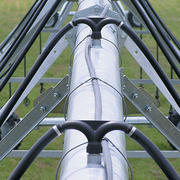
Irrigation practices affect your soil as much as tillage practices, crop rotations, soil amendments and other management choices.
Keeping an eye on water application rate and experimenting with new ways to lower application intensity can go a long way in preserving soil’s structure and infiltration capacity.
Center pivot irrigation has proven successful in achieving uniform water distribution over field crops.
Compared to older irrigation techniques, like surface irrigation, pivots offer accurate water distribution at low pressures (under 30 psi), and the ability to monitor soil moisture and only apply water as needed. They are also one of the most economical options for irrigating on a large scale.
Unfortunately, the efficiency of pivot systems can be a little difficult to maintain when watering tight dense soils with low infiltration rates.
Water infiltrates soil’s pores at varying rates depending on texture. If sprinkler application rates exceed the soil’s infiltration rate, water begins pooling on the surface, resulting in runoff.
Sprinklers that distribute water with high application intensity are also a leading cause of runoff and soil compaction. Higher application intensity disrupts the soil’s composition and leads to surface sealing, which reduces infiltration rates.
Pivot irrigators frequently turned to boom systems or increased pivot speed to reduce runoff, but there are easier and more economical ways to reduce water application rates.
One method is to incorporate thermoplastic double goosenecks into a pivot sprinkler package. Double goosenecks take the water flow from a single outlet on the mainline and spread it out over a larger area using truss rod hose slings.
Spreading water over a larger area lowers the sprinkler’s application intensity, minimizes the potential for surface sealing, and helps soil absorb water at the rate it needs. This reduces surface soil evaporation and encourages deeper movement of water into the soil.
Source
Originally published as "Spreading It Out To Benefit The Soil". SABI Magazine. Volume 7, Issue 4, 2015. Print.


